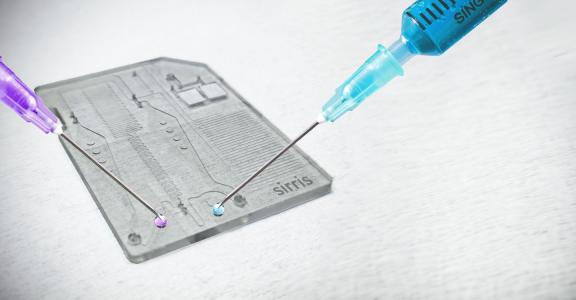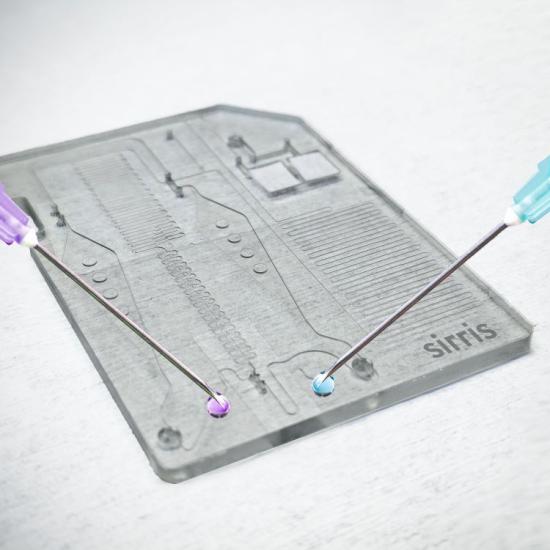Microfluidics in industry
A lab-on-a-chip (LoC) makes it possible to miniaturise complex lab processes and perform them fast and accurately on a microscale. In this article we focus on the aspects of flow control in such microfluidic chips. As explained in the previous articles of this series, it is possible to miniaturise complex lab processes and perform them fast and accurately on a microscale in a lab-on-a-chip. A lab-on-a-chip combines a low-cost, polymeric, single-use microfluidic chip with an intelligent, portable conditioner/reader to meet the requirements for e.g. a point-of-care diagnostic test.
In the COOCK project “Medical Diagnostics goes Micro & Smart”, Sirris brings together the various parties within the value chain of such lab-on-a-chip systems and provides them with knowledge on and support with the production techniques and technologies needed to develop them. Using a demonstrator case, based on the most common process steps in a diagnostic test, the multi-disciplinary development and production approach of the lab-on-a-chip system is walked through and demonstrated step by step during this project.
In this article we focus on the aspects of flow control in the microfluidic chip.
During the different process steps shown in figure 1, it is necessary to control the speed of the fluid front. For instance, each PCR cycle needs to take the same amount of time to achieve the correct conditions in which the reactions can take place. This is not possible by simply applying a constant pressure, because the flow resistance varies due to the density and viscosity of the fluid, which are both temperature dependent, and due to the variation in channel geometry, and hence also the wetted length. Therefore, it is necessary to measure the actual speed of the fluid front, in order to adapt accordingly the pump pressure.
To select an appropriate measurement principle, following aspects have to be considered. Firstly, the fluid is only present in a section of the channels, making it impossible to integrate a fluid measurement device on a specific location where fluid is present during the whole process. Secondly, the displaced air volume between the chip and vacuum pump, although a continuous flow, is too small to be measurable (5 µl/min).
Contactless solution
As a solution, Sirris demonstrates in this project a contactless way, using computer vision, to track the position and velocity of the fluid front inside the chip, which serves as feedback to control the pump pressure. The algorithm uses two successive images to extract information about the position of the fluid front. A small search region is defined around the fluid position, to improve processing time. This allows us to combine the information of several detections, with different spacing between the input images, into more accurate detections with better resolution. To make the measurements more robust, the size of the search region is adapted based on the confidence of the previous measurements. Additionally, the continuity of the detected fluid positions is verified to remove any false detections due to noise or other disturbances. Finally, the speed of the fluid front is estimated from the detected positions and fed back into a PI-controller, regulating the pump pressure.
One of the great advantages of this method is that it does not interfere with the process at all, thus not introducing any disturbances or additional difficulties in the design of the chip. Another major advantage is that it is independent of the chip design and thus applicable to a wide range of different applications, without requiring any adaptation. Some modifications to the algorithm might be required when working with fluids with differing optical properties. However, this does not pose a problem, as the utilised fluids are known a priori, so that the correct algorithm can be selected. In this demonstrator, the algorithm runs on a Raspberry Pi, equipped with a Raspberry Pi camera module, making it a low-cost method, while still being robust and easily adjustable.
In a next article we will zoom in on the thermal control aspect.
Project funding
VLAIO COOCK Medical diagnostics goes micro and smart, HBC.2021.0560
More information about the project
Medical diagnostics goes micro and smart
Would you like to know more?Remember, knowledge and production facilities are available in Belgium to develop and produce lab-on-a-chip systems locally, both the microfluidic chip and the conditioning and read-out device. We can help you get started with your idea! Meet us at our booth 73 on the Knowledge for Growth event in Antwerp on 15 and 16 of May Come to our seminar 'Supplying the life sciences industry: a fast-growing market' on 23 May |







